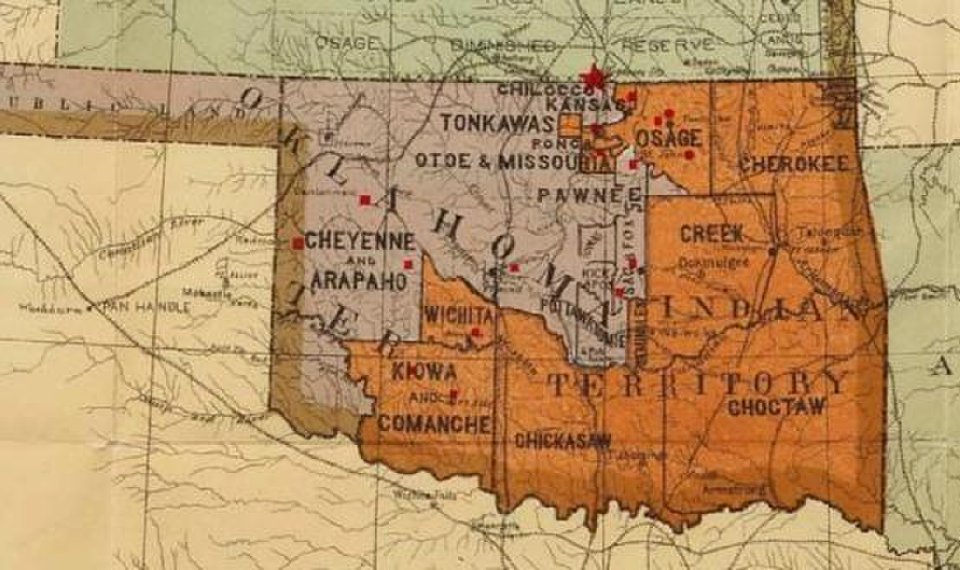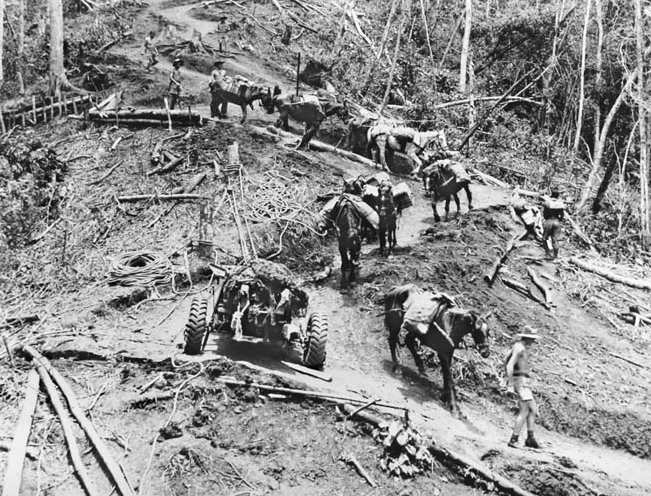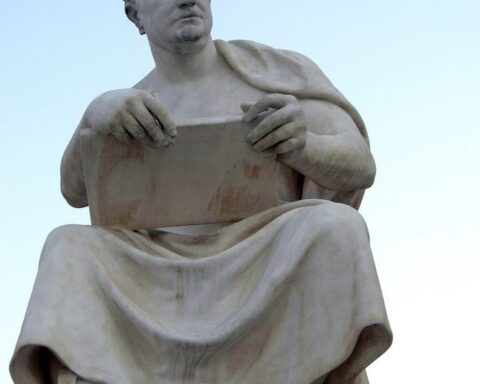Oklahoma is usually the last to follow national trends. First, a trend happens on the West and East Coast. Then, like a wave of the ocean, it rolls inland towards us. We are the last to catch wind of novelties, styles, and policies. For example, it is only now in July that our city is finally forcing us to wear medical face masks in Tulsa. Up until now, only silly paranoid people would wear face masks everywhere. But now, we shall all wear the face diaper of shame.
But one trend that we are actually starting in the United States took place this week. On one day I woke up in Oklahoma, but the next day I woke up in the same bed, and I was no longer in Oklahoma. Instead, I am in Indian Territory. Because apparently, four leftist activist judges on the Supreme Court and one “right-wing” judge voted to uphold a 100-year old treaty. And wouldn’t you know it? It’s an election year, too. As Senator Ted Cruz recently said: “Neil Gorsuch & the four liberal Justices just gave away half of Oklahoma, literally. Manhattan is next.”
I live here. So, it’s in my interest to ask: what are the implications of this? What will happen? And what does this all mean?
For starters, the man who is guilty of rape and been in prison since 1997 will now have to answer to the federal courts, rather than the Oklahoma state courts. Secondly, Indians who are arrested in this place will no longer have to answer to the state. Instead, they will be detained until the local Lighthorse Police (Indian cops) come to deal with them, perhaps saving them for prosecution in a federal court. Of course, if you are not Indian or have any Indian heritage, the Lighthorse Police will not come to you.
Further implications may involve a restructuring of our taxes. Where will our taxes now go? Who will get new funding? To be sure, the local tribes have new empowerment and authority after this Supreme Court ruling. Tribal chiefs and local politicians say that they are happy and willing to work together in cooperation to keep things stable. Time will tell if this continues to be the case, but for now, I am convinced that all parties will work to keep things calm in the short term. Anyone living within the borders of Indian Territory is well aware of the various casinos that lie within it. The tribes have a golden goose, and for now I am not sure that they are willing to kill it. If anything they will want to enrich themselves further.
While it is true that Native Americans now hold a jurisdiction over Eastern Oklahoma, that does not mean that they own the property, necessarily. There are many property holders here, some Indian, but most not Indian. I wonder if those native American Oklahoman who live here—who have their Indian cards—will now get tax breaks or simply not have to pay any kind of state tax whatsoever. That would not surprise me.
What Is Indian Territory Like In 2020?
Before I discuss the long-term implications of Indian Territory’s resurrection, it is important to realize who lives here and the layers of meaning behind this Supreme Court action.
As I’ve already said, the people of Oklahoma are not all Indians. Some are simply non-Indians who moved here from out of state. Some people are descended from the whites who moved here before statehood. Blacks live here, too, and in the past there were actually blacks in Oklahoma who were slaves owned by the Natives. (I find it interesting how, in this unique situation, Indian grievance culture actually overtakes black grievance culture.) Thus, a lot of us are reminded that we are all guests here.
Most of the people here look like regular white people, but sometimes they will talk about their claims to a tribe, the benefits that they get for being in the tribe, their visit to an Indian hospital, or some such thing. They don’t all go out to the local event center for the seasonal powwow and slowly dance around the drummers. I mean, granted, sometimes we will go to Indian museums, sometimes people will buy sweetgrass, sage bundles, or other novelties. Sometimes you will buy Indian tacos at the fair, or hear about people frying up some frybread. But you would not know that these people have Indian heritage unless they told you. A lot of the people here in Eastern Oklahoma are Protestants. They go to mega churches, they’ve grown up in protestant bro-culture, they play their sports, eat their take-out food, and they either root for Oklahoma State University, or more commonly, the University of Oklahoma. Most of us vote Republican, most of us recognize Jesus Christ, and most of us are defiant against the leftist trends of the rest of the United States.
The Left Attacks Oklahoma From Many Angles
Now, the Left realizes that Oklahoma is a deeply red state. We are a Republican stronghold, located right here in the middle of the country. For decades, it is almost as if we have been the beating heart of America (and the Left serving as an insidious, and perfidious cancer eating away at the edges of the United States). Therefore, how then to attack it? How ever shall the Left make incursions into this stronghold?
To be sure, the Left has tried from many different angles. Their weapons of choice have been sanctuary cities, tearing open old wounds with the 1921 Tulsa Race Riot (vulgarity warning on this Watchmen review), the coddling of sodomy – particularly in Tulsa, Oklahoma’s homosexual capital.
The Left has even attacked Eastern Oklahoma spiritually, as I have often covered on my blog. (For access to all my articles about Oklahoma, you can gain access to The Hirsch Files by contacting me privately.) Effective religious orders, including a well-known exorcist, have been expelled from the diocese. The Traditional Catholic community has lost the SSPX, they have been derided by a Novus Ordo replacement priest in one of their home diocesan TLM parishes, and consequently a lot of Catholics have been driven to the FSSP parish, way out in West Tulsa, where the city is currently building a brand new highway right up against the church. In fact, I would even hazard to say that a lot of these troubles started shortly after the 2014 black mass that was allowed to be celebrated on public property in our capitol city. In my mind, it seems that a door was opened with that black mass, and many Catholics would agree with me.
Justice
Now, let’s be honest. What the United States government has done to the Indians is horrible. Treaty after treaty has been tossed into the trashcan. Throughout US history, tribal chieftains have come to the table in good faith, expecting that the Americans would hold to their end of the bargain. Instead, they have been cheated time and again. Cheated, tricked, gaslit, and run over. Most everyone in present day America recognizes that American Indians have been treated extremely unfairly. It is true that many tribes killed off other tribes, attacked white settlers with no provocation, and savagely brutalized various white Americans who came into their path. But if the Christian God truly is the one and only God of the universe, then by God, the men who represented Him should have honored their promises to the pagan peoples of this land, and abided by their treaties.
The United States government and the Americans who came to Indian Territory have slowly nibbled away at whatever remaining sovereignty American Indians have had left. Bite by bite, from one Land Run to another, America slowly creeped its way into the Indians’ jurisdiction, until finally this state became Oklahoma. Yes, it is unfair. These people were forced here on the Trail of Tears from their native lands in the rest of North America. The United States has a legacy of demoralizing conquest and subjugation when it comes to the Indians.
So, yes. The treaty with the Creek Indians needed to be honored.
For over a century, the United States creeped in little by little, and the Congress has never had to make any kind of official proclamation that Indian Territory was gone. And so, a precedent was set, And everyone has been operating for a century as though Indian Territory is just another state. The Congress never officially said anything. Perhaps they thought that they could lay low and not have to deal with the issue.
But now? In 2020, the legal responsibility for declaring something—anything—is getting shafted onto the Supreme Court of the United States. This non-confrontational phenomenon is similar to how Pope Francis refuses to acknowledge the now-forgotten Dubia. Or even, perhaps, this is similar to how the Vatican refused to meet at the table with archbishop Lefebvre when he started up the SSPX. These things have simply been hanging in limbo, waiting for the day when they would finally be addressed.
Shoulda Woulda Coulda
This should have been clearly resolved over a century ago. Indian territory, if they were going to erase it, should have been erased boldly. Their intentions should have been transparent. Instead, they pussyfooted around, saying at first that the territory is going to “forever be set apart as a home,” and then decades later, in union with tribal leaders, they decide to softly swallow up the Indian Territory. For a century, millions of residents and all of America continued under the impression that all of Oklahoma was just another state. If they wanted to continue conquest, they should have finished the job. Instead, they spinelessly let this territory hang.
That said, Chief Justice Roberts, in a fascinating-to-read dissenting opinion of this case, writes of how this ruling is a radical departure from precedent that was already set in the past. Interestingly, he revisits the conditions of the past, which led up to the dissolving of the Five Tribes:
These western lands became the Oklahoma Territory. As before, the new treaties promised that the reduced Indian Territory would be “forever set apart as a home” for the Tribes. E.g., Art. III, id., at 786.1
Again, however, it was not to last. In the wake of the war, a renewed “determination to thrust the nation westward” gripped the country. Cohen §1.04, at 71. Spurred by new railroads and protected by the repurposed Union Army, settlers rapidly transformed vast stretches of territorial wilderness into farmland and ranches. See id., at 71–74. The Indian Territory was no exception. By 1900, over 300,000 settlers had poured in, outnumbering members of the Five Tribes by over 3 to 1. See H. R. Rep. No. 1762, 56th Cong., 1st Sess., 1 (1900). There to stay, the settlers founded “[f]lourishing towns” along the railway lines that crossed the territory. S. Rep. No. 377, 53d Cong., 2d Sess., 6 (1894).
Coexistence proved complicated. The new towns had no municipal governments or the things that come with them—laws, taxes, police, and the like. See H. R. Doc. No. 5, 54th Cong., 1st Sess., 89 (1895). No one had meaningful access to private property ownership, as the unique communal titles of the Five Tribes precluded ownership by Indians and non-Indians alike. Despite the millions of dollars that had been invested in the towns and farmlands, residents had no durable claims to their improvements. Ibid. Members of the Tribes were little better off, as the Tribes failed to hold the communal lands for the “equal benefit” of all members. Woodward v. De Graffenried, 238 U. S. 284, 297 (1915). Instead, a few “enterprising citizens” of the Tribes “appropriate[d] to their exclusive use almost the entire property of the Territory that could be rendered profitable.” Id., at 297, 299, n. 1 (internal quotation marks omitted). As a result, “the poorer class of Indians [were] unable to secure enough lands for houses and farms,” and “the great body of the tribe derive[d] no more benefit from their title than the neighbors in Kansas, Arkansas, or Missouri.” Id., at 299–301, n. 1 (emphasis deleted; internal quotation marks omitted).
Attuned to these new realities, Congress decided that it could not maintain an Indian Territory predicated on “exclusion of the Indians from the whites.” S. Rep. No. 377, at 6. Congress therefore set about transforming the Indian Territory into a State.
Yes, the land was “forever set apart as a home” for the Creek Indians. Nevertheless, the latter allowed white settlers onto their land without a fight. Perhaps, even, they were welcomed, as the white settlers brought economic opportunity with them. And then, of course, there is the case of those “enterprising citizens of the Tribes” who used the land for their own individual purposes, and not for the benefit of the majority of the Tribes. The Natives had their leaders, but they were sold out by them.
Congress began by establishing a uniform body of law applicable to all occupants of the territory, regardless of race. To apply these laws, Congress established the U. S. Courts for the Indian Territory. Next Congress systematically dismantled the tribal governments. It abolished tribal courts, hollowed out tribal lawmaking power, and stripped tribal taxing authority. Congress also eliminated the foundation of tribal sovereignty, extinguishing the Creek Nation’s title to the lands. Finally, Congress made the tribe members citizens of the United States and incorporated them in the drafting and ratification of the constitution for their new State, Oklahoma.
In taking these transformative steps, Congress made no secret of its intentions. It created a commission tasked with extinguishing the Five Tribes’ territory and, in one report after another, explained that it was creating a homogenous population led by a common government. That contemporaneous understanding was shared by the tribal leadership and the State of Oklahoma. The tribal leadership acknowledged that its only remaining power was to parcel out the last of its land, and the State assumed jurisdiction over criminal cases that, if a reservation had continued to exist, would have belonged in federal court.
A century of practice confirms that the Five Tribes’ prior domains were extinguished. The State has maintained unquestioned jurisdiction for more than 100 years. Tribe members make up less than 10%–15% of the population of their former domain, and until a few years ago the Creek Nation itself acknowledged that it no longer possessed the reservation the Court discovers today.
Justice Clarence Thomas agrees with Chief Justice Roberts that the former Creek Nation Reservation was disestablished at statehood, and in his dissenting opinion, he believes that the state of Oklahoma is being attacked by this Supreme Court ruling, and that Oklahoma deserves more respect under the Constitution’s federal system.
Chief Justice Roberts continues to discuss the consequences for Oklahoma after this ruling:
Across this vast area, the State’s ability to prosecute serious crimes will be hobbled and decades of past convictions could well be thrown out. On top of that, the Court has profoundly destabilized the governance of eastern Oklahoma. The decision today creates significant uncertainty for the State’s continuing authority over any area that touches Indian affairs, ranging from zoning and taxation to family and environmental law.
This leads us to the next obvious question: What now? What should be an Indian reservation populated with Indians is now filled with people like me, countless non-Indians, all living and working here as though we are just in another part of the United States Empire. This place should have been a safe haven for Indians. Instead, now we are here. A century long precedent has been set, but now the activist leftists of the Supreme Court want to set a new precedent.
New Vectors of Attack
This creates enjoyable conditions for the Left. For the Left loves to divide. And just look at who voted for this outcome: Kagan, Breyer, Sotomayor, Gorsuch, and Ginsburg. Most of these people hate America as it was founded. The Left loves to sow enmity and strife among a diverse population. And now, there is now a wide range of possibilities for the Left to attack this right wing stronghold. Now that over half of an entire state was thrown up in the air, there are new sequences of events possible.
Will we begin to see building codes violated? Will Oklahoma roads get even worse? Will this inspire tribal pride somehow, and we’ll end up seeing an increase in crime against non-natives? The Left would love this. The Left would love to see the reddest of the red states disintegrate into its own troubles.
And what will happen nationally because of this? Will the Sioux use this case as a precedent to get the Black Hills from the U.S. government? Remember the activism surrounding the Dakota pipelines? Will we see roadblocks and anarchy from other tribes in the United States, as many Canadians have witnessed in Alberta?
Or will life go on, and Oklahoma will remain comfortable and happy as the last to be infected by liberal trends and novelties?
For now, there is no problem between those with Indian blood and those non-natives. However, it is easily imaginable that outside forces might try to embed themselves and create new situations in this state. A lot of leftist activism in this country is being piped in by various wealthy actors and states outside of the Western Hemisphere. Will we see complete lunatics bussed in to stir up some kind of fire in the hearts of otherwise normal Oklahomans? That remains to be seen









